

•
20THMAY ‘24






•



Bees—we all know they are under threat, don’t we?
But why are they so important, and what can be done to mitigate the danger they are in?
At the heart of their importance lies their role as pollinators. This seemingly simple act is crucial for the production of fruits, vegetables, nuts, and seeds. In fact, it’s estimated that one-third of the world’s food crops depend on pollinators like bees. Without them, many of the foods we rely on for sustenance would cease to exist or become prohibitively expensive.
Beyond agriculture, bees play a vital role in maintaining biodiversity. By pollinating a diverse range of plants, they contribute to the reproduction of countless species, thereby supporting entire ecosystems. From wildflowers to trees, bees ensure the survival of plant communities that provide habitat and sustenance for a myriad of other organisms, from insects to birds to mammals…to us humans!
Bees are also indicators of environmental health. Their presence and abundance can serve as a barometer for the overall well-being of ecosystems. Declines in bee populations may signal broader ecological imbalances, such as habitat loss, pesticide use, and climate change. As such, protecting bees and their habitats is not only crucial for their survival but also for the health and resilience of entire ecosystems.
In addition to their ecological significance, bees also have profound cultural and economic importance. For centuries, humans have benefited from the products of bees, including honey, beeswax, and propolis. Beekeeping, or apiculture, remains an important livelihood for many people around the world, providing income, sustenance, and even therapeutic benefits.
Despite their immense value, bees face many threats to their survival. Habitat loss, pesticide
exposure, disease, climate change, and invasive species all take their toll on bee populations. The widespread use of neonicotinoid pesticides has been implicated in the decline of bee populations worldwide, leading to calls for greater regulation and alternative pest management strategies.
Fortunately, there is growing recognition of the need to protect bees and support their populations. Efforts to conserve and restore bee habitats, reduce pesticide use, and promote beefriendly practices are underway in many parts of the world. From urban beekeeping initiatives to pollinator-friendly gardening campaigns, individuals, communities, and governments are taking action to safeguard bees and their vital ecosystem services.
As individuals, we can help by:
• planting a diverse set of native plants, which flower at different times of the year
• buying raw honey from local farmers
• buying products from sustainable agricultural practices
• avoiding pesticides, fungicides or herbicides in our gardens
• protecting wild bee colonies when possible
• sponsoring a hive
• making a bee water fountain by leaving a water bowl outside
• helping to sustain forest ecosystems
• raising awareness around us by sharing this information within our communities and networks
GO ON, HELP SAVE THE BEES – THE WORLD WOULD BE A VERY DIFFERENT PLACE WITHOUT THEM!

We offer routine foot care and HCPC registered specialist Podiatry services
ROUTINE FOOT CARE
NAIL CARE
CALLUS & CORNS
VERRUCAE

Specialist Podiatry Services
FUNGAL NAIL TESTING & TREATMENT
DIABETIC FOOT REVIEW
COSMETIC PODIATRY, INCLUDING ME
PEDICURES AND NAIL RECONSTRUCT

FOOT PAIN ASSESSMENT & TREATMENT PLANNING INC. ORTHOTICS,
EXERCISE PRESCRIPTION AND MLS LASER THERAPY
SURGICAL PODIATRY
NAIL SURGERY
VERRUCA NEEDLING
PODTOX HYPERHIDROSIS TREATMENT
CURACORN TREATMENT FOR STUBBORN
CORNS AND FAT PAD ATROPHY
Sports massage describes a clinical massage, that is different to a typical relaxation massage, rather than a massage for sportspeople.
We’ve partnered with Jen @ Active Release who provides sports massage therapy from our premises at Ashfield Therapy Centre. Jen uses a variety of techniques to help reduce inflammation, improve range of motion and help you reach your goals....whether they’re sporty or not!
If you’re interested in a sports massage, call our Reception team on 01623 723 328 to book in
We are based at: Did











Nottingham Trent University continue to deliver the Enterprising Ashfield project to businesses, residents and employees within the Kirkby-in-Ashfield and Sutton-in-Ashfield Towns Fund area.
FREE COURSES
£1,000 BUSINESS START-UP GRANT
£1,500 BUSINESS GROWTH GRANT
£2,500 GRADUATE TALENT GRANT
FREE EXPERT BUSINESS SUPPORT
FREE APPRENTICESHIP ADVICE

Contact us to book an appointment with one of our Business Advisers and visit our website to find out more, including full list of courses available
enterprisingashfield@ntu.ac.uk
ntu.ac.uk/enterprisingashfield








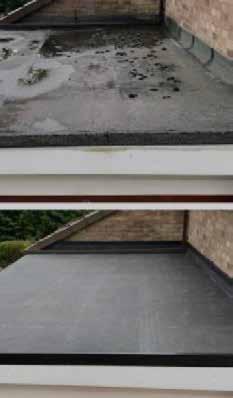


We are proud to have offered our services to the area for over 20 years building up our reputation by offering a high service at affordable, honest and reasonable prices to both residential and commercial customers. Many of our customers are return customers or gained through ‘word of mouth’ and we welcome this loyalty. 24 HOURS 7 DAYS A WEEK


We tailor services to your personal needs: personal care, medication, companionship, meals, shopping, outing, exercise and domestic duties. All care is person-centred and reviewed to suit changing needs.













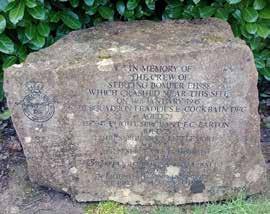
Just a goal-kick away from the throng of heavy traffic where the A611 Derby Road and the A608 Mansfield Road converge at the island opposite Sherwood Business Park Annesley, sits a monument that may not receive the prominence it truly deserves.
It may be well known to locals, walkers like me, and the employees in this part of the world. However, it’s certainly concealed from the sight of the thousands of people who hurtle past in their vehicles every single day.
The RAF Stirling Memorial in memory of the crew of Stirling Bomber Serial EH 988 which crashed near this site on 14th January 1945. Those that perished were:
67707 Squadron Leader S.L.Cockbain
D.F.C aged 28
1587047 Flight Sergeant E.C.Barton aged 21
2204311 Sergeant J.Littlemore aged 19
1651299 Sergeant K.Harris aged 22
1874899 Flight Sergeant T.A.Ball aged 20
The Memorial Plaque reads:
“This four-engined bomber was on a flight from RAF Winthorpe to Northern Ireland when it suffered a loss of power, first from one engine, and then from two. The pilot struggled to control the aircraft and attempted to reach RAF Hucknall. As the machine became increasingly unmanageable, he had no option but to attempt a forced landing in the fields. Unfortunately, however, the aircraft continued to

lose height rapidly as it made a wide turn over this area. It flew in an easterly direction near the site of this Memorial and crashed into the ridge just to the east of here.”
Average age of the crew, 22 years. It continues,
“After information about this crash had been researched and published, it was decided to form the Stirling Memorial Group consisting of the organisations named below for the placing of a memorial on this site. The inscribed Memorial Stone was unveiled by Group Captain R.Cook B Tech RAF and dedicated by RAFA Chaplain the Rev Jeremy Fletcher on 16th September 1998 in the presence of surviving relatives, RAF veterans, comrades from other Arms of Service, and members of the Public.”
If you happen to be in this part of Nottinghamshire, then this Memorial Stone and site are worth a few minutes of your time.
And like countless others who paid the supreme sacrifice so that we might enjoy our freedom today, old age and time was something never afforded to this brave young aircraft crew.

Words by Roger West










Our staff are all local and each one of them is matched, designated and specifically trained to understand and meet your needs. You can choose occasional weekly visits, frequent daily visits or 24/7 care enabling you to make the most of life in your own home. www.leymarhealthcare.co.uk We will work with you, your family and other professionals involved, to design a package that fits in with your current routine.









BUY,SELL,EXCHANGE AND REPAIR GOLD JEWELLERY
Competitve rates and best prices paid 5% DISCOUNT IF YOU CUT OUT AND SHOW THIS ADVERT Also Videos (All formats) transferred to D.V.D etc...
Enquiries@kirkbygold.co.uk
www.kirkbygold.co.uk • Tel: 01623 756 816
56,Station Street, Kirkby in Ashfield, NG17 7AS
Which soap do you remember from your childhood? There were many brands to choose from in the 1960s and 70s like Lux or Camay Beauty soaps where the model on the television advert demonstrated how to use the soap by rubbing in circular movements blobs of lather on her cheeks. My granny was not impressed when I tried this method and she told me to go back and wash the whole of my face.
During WW2, soap was rationed as the fat and glycerine from it was needed to make explosives and for other military uses.
From 1942, four coupons were given each month, and each coupon was worth 4oz hard soap, 3oz toilet soap, half an ounce of liquid soap, 6oz soft soap, 3oz soap flakes or 6oz soap powder. Shaving soap was never rationed but became scarce as did the other types.
Soap operas from radio (1930s) and TV (1950s) were so called because they were sponsored by soap manufacturers.


Washing powders like Oxydol and Rinso had to perform more than one household task. The wartime Rinso packet had instructions for how to use for laundry and dishwashing.
Knight’s Castille, Palmolive, Pears, Fairy, Sunlight, Imperial leather, Carbolic, Lifebuoy, Coal tar, Pit Head Bath soap if your father was a miner, were the types I grew up with. To imagine my parents and grandparents having to go without what we regard as basic cleaning products and five inches of water in your bath for the whole family a week, makes me glad I didn’t have to live through those times.


Janet and Paul Barrass are All Around the Shire. Find us on or email: oldfield512@btinternet.com for more information.


ALL HALF BOARD INCLUDING EXCURSIONS & ENTERTAINMENT!
EASTBOURNE
Haddon Hall Hotel
Fri 24th - Tue 28th May 5 Days - £425
SCOTLAND SAIL & RAIL
Winnock Hotel, Drymen
Tue 4th - Sun 9th Jun 6 Days - £745 COACH
TORQUAY
Livermead House Hotel
Thu 6th - Mon 10th Jun 5 Days - £499
BOURNEMOUTH
Marsham Court Hotel
Mon 17th - Fri 21st Jun 5 Days - £499
WARNER LEISURE
Heythorp Park, Cotswolds
Mon 1st – Fri 5th Jul 5 Days - £645
NORTHERN IRELAND
Ramada Hotel, Belfast
Tue 2nd - Sat 6th Jul 5 Days - £625

WESTON SUPER MARE
Smiths Hotel
Sun 7th - Thu 11th Jul 5 Days - £475
PORTHCAWL
Seabank Hotel
Wed 10th – Sun 14th Jul 5 Days - £465
WILTSHIRE WARNERS
Littlecote House
Mon 26th – Fri 30th Aug 5 Days - £475 (Halfboard)
MOBILE BOOKING OFFICE LOCATIONS
1st Friday of each month 9.30am - 1pm | Shirebrook market
2nd Tuesday of each month 9am - 1pm | South Normanton Market Place
2nd Friday of each month 9am - 1pm | Ripley Market Place
3rd Thursday of each month
9am - 1pm | Alfreton Severn Square Car Park (Outside B&M)
3rd Friday of each month
9am - 1pm | Sutton-in-Ashfield, Portland Square
All our BRITISH MADE sofas, chairs & recliners are made to order and normally delivered within 6-8 weeks. Choose from over 2000 fabrics and leathers.
Only 100% genuine leather used on all our Italian suites, which are made to order in any colour and normally delivered within 8 - 10 weeks Reupholstery, repairs & cushion replacement service available - call for appointment








T: 01773 549035 | E: info@voicemagazines.co.uk | www.voicemagazines.co.uk
Method:
1. Heat your oven to 200°C/fan 180°C/ gas 6.
2. Cook the potatoes in a large saucepan of boiling water over a high heat for 15 minutes or until tender. Drain, return to the pan and mash well. Leave to cool then stir in the quark, season to taste and set aside.
3. While the potatoes are cooking, put the leeks and 2 tbsp water in a nonstick saucepan over a medium-high heat. Cover and cook for 10 minutes or until tender, stirring occasionally, then tip into a large ovenproof dish.
4. At the same time, cook the eggs in another saucepan of boiling water over a high heat for 9 minutes or until just hard-boiled. Cool under cold running water, peel, halve and add to the leeks.

The Ashwood Centre Portland Street, Kirkby in Ashfield, NG17 7AB 5.30pm & 7pm
Tel: Jayne Wood 07766 693881
slimmingworld.co.uk

For more information visit www.slimmingworld.co.uk

This fish pie is packed full of delicious ingredients; fish, prawns, eggs, leeks in a creamy sauce, all topped with fluffy mash. Yum!
5. Pour the milk into a non-stick saucepan and bring to a simmer over a medium heat. Add the white fish, reduce the heat to low and cook for 5 minutes. Using a slotted spoon, carefully transfer the fish to the ovenproof dish, along with the prawns, herbs and lemon juice.
6. Strain the milk into a clean pan and put it over a high heat. Mix the cornflour with a little cold water and add to the milk. Bring to the boil, reduce the heat to low and cook for 2 minutes, stirring often. Pour the thickened sauce over everything in the dish, season lightly and gently mix it all together.
7. Spoon the mashed potatoes on top, making a pretty pattern with a fork if you’re feeling creative, and bake for 20-25 minutes or until the topping is lightly browned. Serve with your favourite Speed vegetables.
Serves: 6
Ready in: 1 hour 10 minutes
Ingredients:
• 1kg floury potatoes, such as King Edward or Maris Piper, roughly chopped

• 4 tbsp plain quark
• 2 large leeks, sliced
• 4 eggs
• 250ml skimmed milk
• 600g skinless and boneless white fish fillets, cut into bite-size chunks
• 200g cooked and peeled king or tiger prawns, tails removed
• ½ small pack fresh dill, chopped
• 2 tbsp freshly chopped parsley
• Juice of ½ lemon
• 1 level tbsp cornflour
Syns per serving: 1


- 100’s of designs
- Free design & quote
- 10 year guarantee
- Family business over 20 yrs
- Honest pricing policy
- All made in-house
- Fit within 3 weeks of order
- Installation within 1 day Book your free design visit now 0115

Chooseyournewblinds&curtainsfromthecomfortof yourownhomewithourfreehomesurveyorvisit ourshowroom(Just2minsfromIKEA)

















Well, it finally feels as if Spring has arrived and with it a bit of drier and warmer weather. So, it’s the perfect time to dig out this gem. It really is a lovely walk, with beautiful views and scenery. There is a nice varierty of terrain as the walk leaves from Calver, along the River Derwent to Froggatt and then as far up as Grindleford, before heading back through Froggatt Woods and along the river to return to Calver.
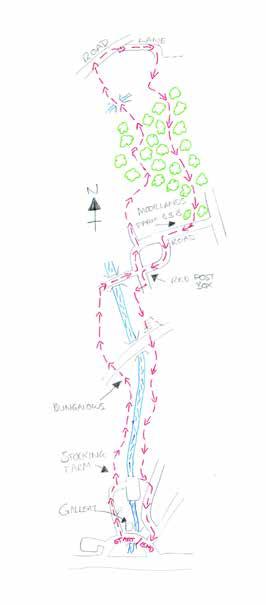
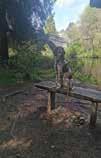
A mid-length walk which should take you and your dog around 2½-3 hours to complete. The walk is mostly on trails and paths but there are a few short stretches of road so please take care. Please wear appropriate footwear and as always, please follow the countryside code.
1. Facing the gallery take the single-track tarmac road to the left signposted for ‘Calver Mill’. After some distance ignore the gate to the right into Calver Mill and continue straight ahead passing a sign on a stone post for ‘Stocking Farm’.
2. Just prior to reaching some farm buildings follow the road around to the right. After, turn immediately left and pass through a small wooden gate adjacent to a large wooden gate and continue to cross an open field.
3. Upon reaching a river on your right continue ahead keeping the river close on your right. After a short distance pass through a small wooden gate adjacent to a large metal gate. Now continue along a footpath with the river on your right.
4. Pass 2 bungalows on your left, then after a short distance you will reach a road. Cross the road to pass through a gap and then continue along a footpath with the river on your right.
5. After a short distance cross over a footbridge and then continue with the river on your right for some distance, passing through three more wooden gates.
6. Eventually pass through a wooden gate onto a road. Turn right to cross over the river and after a very short distance turn left at a T junction along a road called ‘Hollow Gate’. Continue ahead until the road bends sharp right and uphill. At this point continue straight ahead along a road and a footpath signposted for ‘Grindleford Bridge’.
7. The road turns into a lane with a dry-stone wall on both sides, then into a footpath. Shortly after this pass through a gap adjacent to a large metal gate, into a field, and continue with a dry-stone wall on your right. When the dry-stone wall on your right comes to an end bear slightly to the right following an arrow on a marker post, to continue to cross an open field.
8. Pass through a gap and then continue with a dry-stone wall on your left for some distance before passing through another gap to cross an open field. Pass through another gap to follow a signpost for ‘Froggatt Wood’.
9. Continue along a footpath through woodland and crossing several streams. Pass through a gap and then continue with a stone wall on your left. Then pass through a small wooden gate adjacent to a large wooden gate and cross an open field going downhill.
10. At the bottom of the hill bear slightly left to cross over a stream and continue ahead to pass a telegraph pole on your right. Cross an open field and at the far side pass through a wooden gate and onto a road. Turn right along the road for a very short distance and then turn right along a lane and signposted footpath.
11. After some distance follow the lane sharp right and after a very short distance pass a marker post on your right. Ignore the path to the left and continue straight ahead to cross over a stream. After a very short distance pass through a small wooden gate just off to your right and enter a field.
12. Cross the field towards a marker post. At the marker post turn left signposted as ‘The Wellington Boot Route’. Pass through a large gap in a wall pass by two marker posts on your right.
13. You will begin to enter some trees. Pass two more marker posts on your left and continue along a wooden walkway to pass through a wooden gate and uphill through the trees until you reach a drystone wall in front of you. Bear slightly right and continue with the wall on your left, ignore a gate on the left and contine.Then, following an arrow on a marker post on your right, pass through a large gap in the wall on your left.
14. Continue straight ahead, now, with the wall on your right. After some distance cross over a stream on your left and then continue ahead to cross over a walkway/bridge. Immediately after
the bridge pass through a large gap in a wall directly in front of you.
15. Still amongst trees follow the arrow on a marker post on your left to continue ahead. At a marker post with an arrow pointing to the left follow the arrow on a path of laid flag stones.
16. Cross over some stepping stones over a fast running stream, then continue to cross over two more streams. Pass a marker post on your right, then cross over another stream. Continue gently uphill for some distance, eventually the path continues with a wall on your right. Pass through a small wooden gate adjacent to a large wooden gate onto a road.
17. Turn right, then shortly after passing ‘Moorlands Farm Bed & Breakfast’ on your right, turn left along a road called ‘Malthouse Lane’. Continue along ‘Malthouse Lane’ for some distance and then at the far end of the road follow it sharp around to the right and downhill.
18. At a T-junction turn left. Continue ahead, ignoring a road on your right and then look out for a small wooden gate on your right. Pass, through to continue along a footpath with a river on your right. Cross over a footbridge and then continue with the river on your right.
19. Continue for some distance and then at a split in the path take the right split, reaching some steps up to a road. Cross the road, pass through a gap and then continue along a footpath with the river on your right. After some distance climb up some steps, cross over a footbridge and then continue with the river on your right.
20. After some distance cross a wooden footbridge, climb some steps and continue with the river on your right. Further on pass through a small wooden gate along the path.
21. Pass through the wooden gate onto a road. Turn right and continue for some distance, reaching a junction. Turn right along a road and cross over the river to return to ‘Calver Mill Gallery’

This walk is for illustrative purposes only. Voice Magazines Ltd takes no responsibility for anyone who chooses to follow this route and encourages all walkers to obey all byelaws and signs and to respect the area they are walking in, ensuring they pick up all dog mess and obey the countryside code at all times.




































In the County of Nottinghamshire, the Annesley Estate has seen many changes. Within Sherwood Forest the generations of farmers and labourer’s on the land have lived through Religious differences, Civil wars, industrial expansion and emigration to new lands.
When the Domesday Book was written in 1086, the information of Manors was recorded for taxes to the ruling court, Anneslie had a small place of worship, with a Saxon foundation.
Some time ago, there were effigy’s of a Knight Chaworth and of Lady Leonia De Raines, who founded the Felley Chapel, these are now at the New All Saints Church along with other important items from the Chaworth and Musters family homes.
The records show in 1442 a George Chaworth wed Alice Annesley, but as the main family estate was in Wiverton, Annesley only took prominence after Civil war actions, causing the Royalist Chaworth’ s to settle away from lands at Langer. One feature that was on the Tower of the Church is the Chaworth

Achievement. Marked 1686 the coats of arms of many inter married families.
As the estate supported many families, the normal Services, Baptisms, Weddings and funerals took place. Parish registers exist that make fascinating reading both social and family history. Burials are in the Church and those with long connections in the Churchyard. When in the 1850’s the children of the late Mary Ann and John Musters, returned from Norfolk with guardians, the Estate was overhauled.
The Old Church itself gradually became used less as the Annesley Colliery was sunk, and the miners settled in the Rows, the New Church was founded. When DH Lawrence the writer, walked the area, he spent time in the Old Church, giving him inspiration for his books. During the 1960’s a very bad winter caused the roof to collapse and this was the beginning of the end.
The Kirkby and District Conservation Society looked after the Church in the 1980’s funding some work and getting the tower Grade one listed.
Unfortunately, it had to be sold and Ashfield District Council took it on. 2011 a Friends Group was formed to work with the Council and National Lottery Heritage funding. After covid and ill health, the Friends Group are hoping to re-group for 2024. We sometimes are on site checking all is ok and chatting to the many visitors from all over the world.


BEING INTERESTED IN LOCAL AND FAMILY HISTORY, I HAVE A FACEBOOK PAGE “ANNESLEY OC HERITAGE EXTRA”, WITH MANY EXCITING FACTS ABOUT THE AREA WITH PICTURES AND COMMENTS. WHY NOT TAKE A LOOK?





From supply only to full installation we offer the full package. Our experienced and knowledgeable design teams are here for you, offering a full, free of charge planning and design service. If you’re after a bathroom or kitchen we are serious about creating the best design possible to suit your budget.










There’s nothing like a bit of gothic thriller for immersing yourself in another world and author Michelle Paver has a great talent for suspense and menace. Her other gothic novels, Dark Matter and Thin Air, were bestsellers and Wakenhyrst, the most recent book, is another treat for fans of creepy, gripping and spooky tales.
It’s an engrossing clever story, atmospheric and dark, centred around Maud, a young girl who grows up in a

grand house on the edge of the Fens. Her mother dies in childbirth and her life is ruled by her despotic father who she adores – until she starts to find out about his secrets.
Paver builds tension brilliantly. Maud is a superb brave heroine, her father a perfect villain. Religion, superstition –and a clever narrative around the place of women in Edwardian times. What’s not to love?











Pitcherwits® are crossword puzzles where some of the clues are in pictures.
Sound easy? It’s not called “Pit-your-wits” for nothing!
The mixture of cryptic and picture clues, combined with Professor Rebus’ unique sense of humour, will keep you entertained for hours.








These puzzles are devised by the brilliant Professor Rebus. For more of his puzzles visit www.pitcherwits.co.uk








































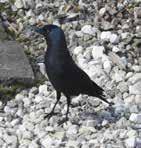
From autumn into late winter the garden visiting birds have grown in numbers and diversity. Then, a few weeks ago as the first warmth seemed to arrive, many of the birds reduced. Night-time temperatures make a big difference because if it is very cold then small birds burn up body fat. This needs to be replenished the following day and as a matter of urgency – if they don’t refuel then small birds die. Indeed, this is why our garden feeders become so important in wintertime. However, a couple of cooler nights brought the numbers back up and whilst the titmice (blue, great, and coal tits) have never got back to the highs of a couple of months ago, the finches in particular have been doing very well. Usually, a winter visitor I think the siskins may be stopping to breed locally, with several still on my feeders at any one time. They are joined by greenfinches, bullfinches, chaffinches, and goldfinches, all of which will, it seems, breed in or around the garden.
Jackdaws have returned to nest in a neighbour’s chimney stack, and the local carrion crows have a nest and territory in a nearby woodland. Both species are coming to the garden to feast on the hanging fat-balls. Also in the wood, a chiffchaff started singing in late March almost like somebody just threw a switch and the song ‘chiff-chaff, chiff-chaff, chiff-chaff’ started up. This is not to be confused with the bi-syllabic, repeated ‘seesaw’ of the local great tits. Another loud and insistent call is that of the nuthatches that hold territory and occasionally come to the feeders. At this time of year, the repeated ‘chwit-chwit’ and the loud, ‘kee-kee-kee’ are

very distinctive. Much of the bird activity is now settled on establishing a breeding territory whilst attracting and protecting a suitable mate. But levels of activity will carry on growing as summer-breeding migrants pour in from April onwards. As always, the period from May to August promises to be a very busy time for the songbirds of the Peak District!
Along with new arrivals from the south, many of our winter birds will have departed northwards to their own breeding grounds. This may be the far north of Britain or else back into northern Europe or even Iceland. This is a time of great change, and for birds such as the starling for instance, our winter population includes gatherings of hundreds of thousands or even up to a million birds. Some of these breed locally but many head back across Europe for the summer. In Russia for instance, the return of the starling is viewed as a harbinger of springtime, very much as we await the coming of the swallow back from Africa. Even our population of winter blackbirds mixes those which reside here and breed locally, and a big influx of continental birds from across the North Sea. Of course, once all this movement is settled and the birds have bred, then it will all start over again for the next winter period.











With over 20 years experience in manufacturing and installing garden rooms across the UK our team can create your family the perfect space to use all-year-round. Visit one of our open-air show sites in the Midlands to see a variety of garden rooms, garden bars, home office solutions and BBQ Cabins.

Top Tip:

May is such a brilliant time in the garden. Time to plant out, sow for later in the summer, take cuttings to give you more plants for free. It can’t get any better than this.
It’s also a good time to prune forsythia to keep a bright bushy shape and plenty of blossom next year.
Tender plants which have been started off indoors can be hardened off now – take them outside during the day and bring under cover at night for a few days then they won’t be shocked into slower growth. You also need to be careful with baskets and containers. They can be planted up as soon as it feels like the frosts are over but have a couple of rolls of fleece handy if it feels like it’s going to be a cold night.
If you’ve got seedlings growing in rows or pots thin them out once they’ve got a couple of proper leaves (ie not the little leaves that emerge as they start to grow). This way they’re less likely to suffer from fungus and they have a better chance of flourishing if they’re not having to fight for space.
Watch out for bright red lily beetles. They can attack fritillaries as well as lilies and will very quickly decimate your plants.
You can keep on sowing bright summer annuals in beds – they’ll give you bright colour around the end of July and August when bare patches start to show.
Feed your daffs and tulips with a liquid fertiliser now to encourage a good strong display next year.















✽ 2 spacious en-suite bedrooms
✽ A fully enclosed garden
✽ 2 small to medium dogs welcome (3 upon request)
✽ Fully equipped kitchen, including an American style fridge freezer


✽ Perfect for exploring the stunning Northumbrian Heritage Coastline
✽ Close to a range of dog friendly pubs, cafes and restaurants in stunning Warkworth
✽ We have fast fibre Wi-Fi and smart TV’s Search ‘The Little Red Hen House’ at:


Treat yourself to a luxury break at the 4* Gold Award winning Little Red Hen House. An elegant and cosy holiday home just a 7 minute drive from award-winning and dog-friendly Warkworth beach. www.coquetcottages.co.uk








